Study On the Impact of Open Residential Block on Urban Traffic Congestion Based on Dynamic Com-prehensive Evaluation Model
(1.Foundational Courses Department of Shandong University of Science and Technology;2.Information Department of Shandong University of Science and Technology,Taian 271000,China)
Abstract:The growing use of vehicles with the development of China brings greater pressure on the existing road traffic network.Based on the domestic and international research experiences and the domestic congestion situations,this paper selected six indicators that a ff ect the traffic conditions.As each single indicator cannot reflect the detailed traffic quality separately,the dynamic comprehensive evaluation principle is adopted.Then we used the principle of”Variation Driven” to determine the weight vector of each sub-indicator,and established a multi-indicator comprehensive evaluation system through the dynamic weight of each sub-indicator.Finally,the rationality and feasibility of the system is demonstrated by case analysis.This provides a strong theoretical foundation and basis to mitigate traffic congestion.
Key words:Multi-index e ff ect;Dynamiccomprehensive evaluation;MATLAB;Vehicle traffic simulation system
§1. Introduction
Traffic Congestion is not a new problem.It has been a big problem in ancient Rome,in London in the 18th century,and in New York in the 19th century.In recent years,with the rapid economic growth in China,the traffic congestion has become more common and severe.On February 21,2016,the State Council of the People’s Republic of China promulgated the“Opinions on Further Strengthening Urban Planning and Construction Management”,where the Article 16“promoting the block pattern and gradually opening the existing walled residential communities and organization campuses”has caused extensive attention and discussion.
Some people believe that the walled communities broke the urban road network structure,blocked the city “capillaries”,which caused the traffic congestion condition.After opening such communities,the density of road network and the road area will be increased,and the traffic capacity will be naturally improved.Also some people believe that such modification depends on the area and location of the residential communities,the external and internal road conditions and many other factors.Therefore,it cannot be generalized.However,some people hold that after opening the residential communities,the increment of the number of accessible roads will also bring up the number of vehicles entering and leaving the of the communities from the intersections on the main roads,which has the possibility to lower the traffic speed on the main roads.
In order to evaluate the influence of opening communities on the traffic on the surrounding roads,this paper selected six indicators namely traffic density,maximum capacity,saturation,delay rate,through extensive collection,review and collation of domestic and international traffic congestion status and evaluation literature.It is impossible to describe the traffic condition quantitatively while considering one indicator unilaterally.Therefore,this paper used the multi-indicator comprehensive e ff ect evaluation system to reflect the impact of the opening communities on the traffic on the surrounding roads in the numerical form according to the variations in the evaluation system,combining with the influence of opening communities on each sub-indicator.
§2. Traffic Congestion Evaluating Indicators
To study the impact of community opening on surrounding road traffic accurately,we need to select the traffic congestion evaluation indicators that suit our cities’characteristics best.The developed countries began to study the indicators in the 1950s.Meyer,Michael and Byrne established the congestion indicators for some major urban areas.However,the indicators cannot function when compare the congestion occurring at di ff erent locations or times[1,2];Considering that di ff erent road sections and city areas have di ff erent characteristics,Lindley,Schrank,Marlon collected abundant statistical data.And they designed the parameters for the congestion indicators.[3,4,5];Daniela Bremmer et al proposed the concept of time reliability,and proposed a new principle of congestion evaluation,that is,using real-time evaluation method6];The study of urban congestion management technology in our country was relatively late.At present time,the research on congestion indicators is still in the process of learning and discussing,[7-11];Congestion is a complex phenomenon in urban traffic.It’s difficult to use a single indicator to describe how all the travelers focus on the congestions.
Therefore,we consulted domestic and foreign data related to traffic system performance indicators.And we selected six evaluation indicators which can reflect the congestion degree.They are traffic density,maximum capacity,saturation,delay rate,speed and circulation The detailed introductions for each indicators are listed as following:
Traffic density indicates the number of vehicles present on a unit road length at a certain instant.
Traffic densityρcCalculation
N−several vehicles
l−Observing the length of the road
The maximum capacity C indicates the maximum number of vehicles passing through a designated
V−The actual traffic volume of the imported lane
C−Capacity of imported lane
The delay rate d represents the time loss rate of the road

T—Analysis period
m—–normal parameter,m=0.5
L—-Correction parameters for independent signalized intersectionsL=1.0 section on the road per unit time.
The saturation S represents the ratio of the actual traffic volume to the traffic capacity at the intersection,which is the congestion degree of the intersection.
§3.Principles of Dynamic Comprehensive Evaluation
Dynamic comprehensive evaluation means that the object is comprehensively evaluated with several indicators with the timing characteristic to reflect the dynamic development(or operation)changes of the evaluated object at di ff erent times.In order to evaluate the impact of the opening residential communities on the traffic on the surrounding roads,this paper selected six evaluating indicators:i.e.traffic density,maximum traffic capacity,saturation,delay rate,speed and traffic volume.The observation of the kth time-point tk(k=1,2,···,N)is markedas
follow:
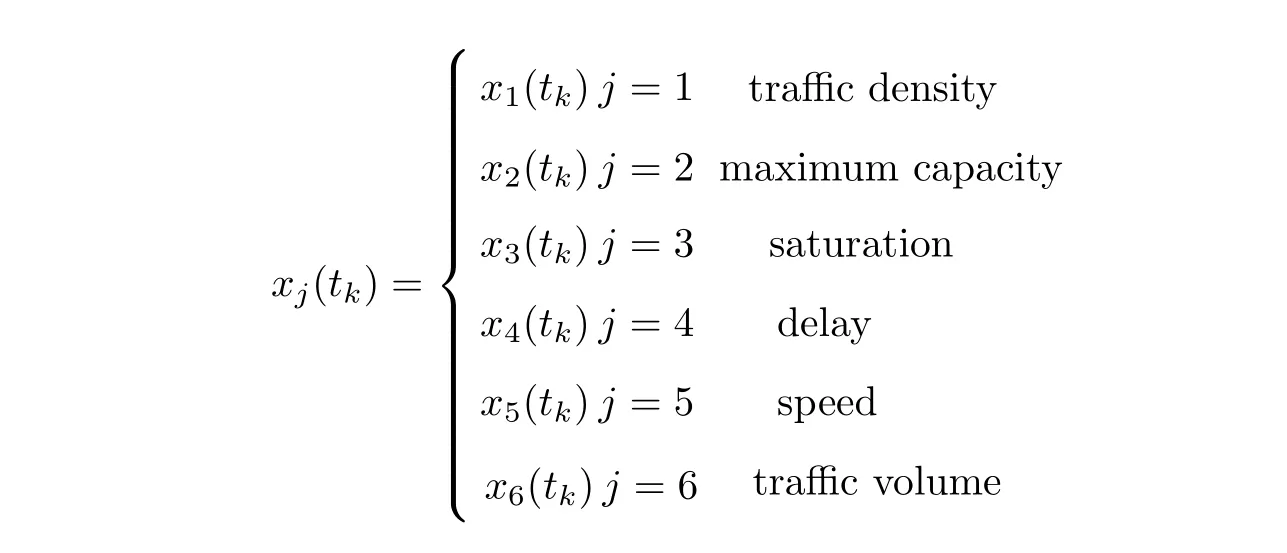
Here we describe the situation at di ff erent time-pointtkwith the state vector.

In order to make the model intuitive and easy to understand,we choose the linear function as the evaluating function,namely:

Where wj(tk)=(w1(tk),···,w6(tk))Trepresents the weight vector to be determined at the time-pointtk,in order to make the model more objective and fair,the data matrix A of the indicator sample value of the object is required to be fully analyzed.
We use the principle of”variance drive” to determine the weight vectorwj,where the weight coefficient should be a measure of the variation of each indicator and the impact on other indicators.The weighting original values come from the original statistical data of the object,and the weight coefficient of corresponding indicator should be determined based on the amount of information provided by each indicator.In the dynamic comprehensive evaluation,when the implicit relation between wjand time-point tis supported by the sample data matrix[12],wjcan reflect the fullest extend of the whole system in principle,and the di ff erence between the conditions at di ff erent time-points results in the biggest sum of the squared deviations y(tk).wjis given by the following linear programming problem:

§4.Model Simulation Calculation
4.1 Simulation before opening
By visiting the traffic management department of our city,we got a set of data to evaluate the traffic congestion as following
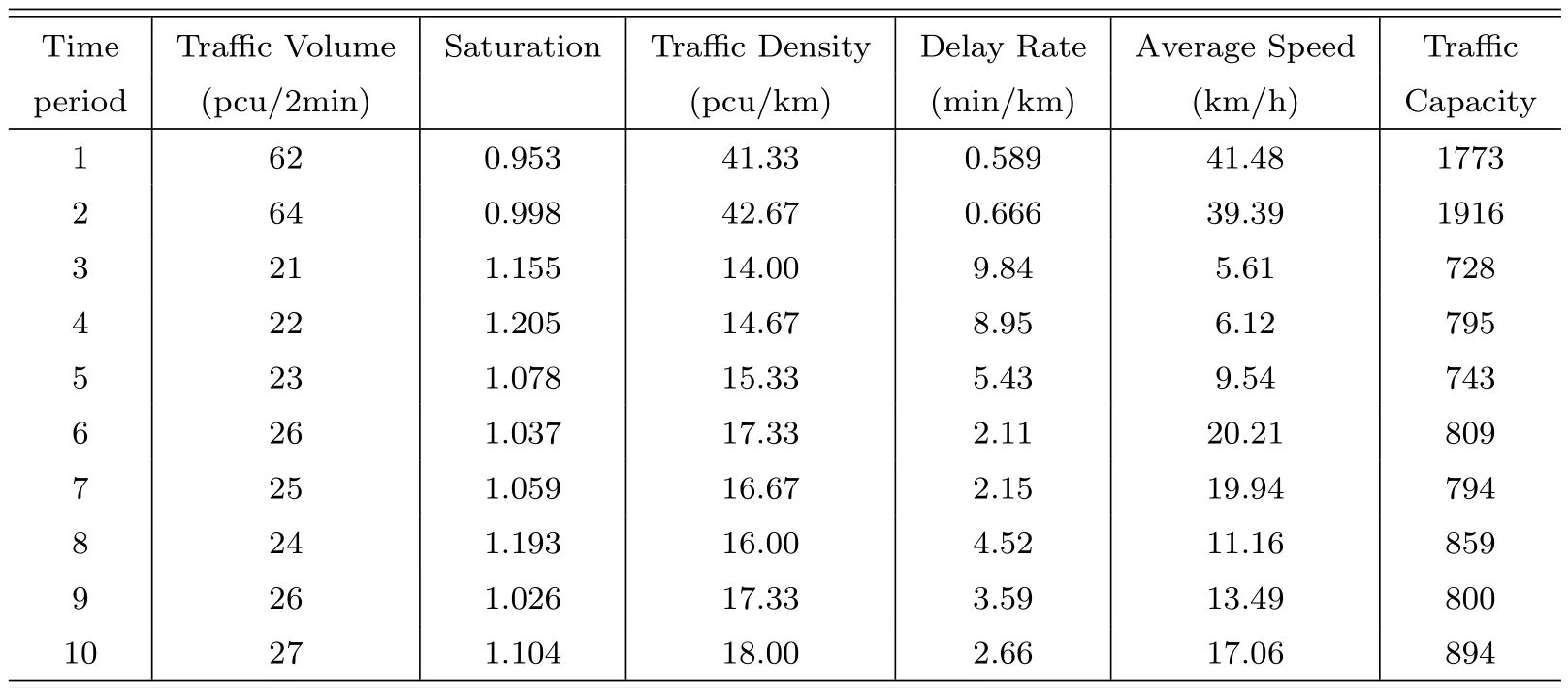
Table 1 Table 1 Road Data Survey
Use the z-score standardization method to non-dimensionalize the original data.

The calculated value of the original indicator data after standardization is shown in the following table
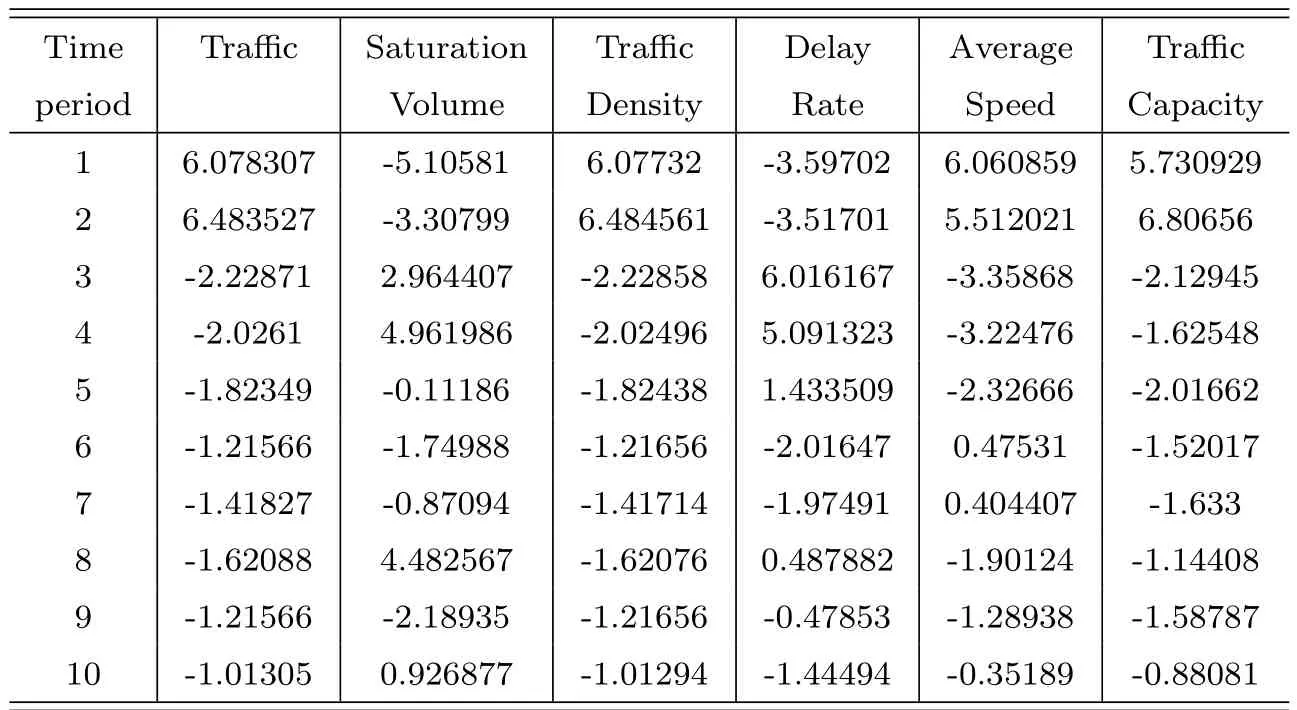
Table 2 Calculated value after standardization
Substitute calculated indicators from 1 to 10 time period in A and calculate theH matrix

The maximum eigenvalue of H is 1.064e-06.The corresponding eigenvector is

Standardize this eigenvector to get the indicator weight vector is


Table 3 Calculation Results
4.2 Simulation after opening
Due to the existing constrains,it is hard to find the data of the traffic change status of the relevant community before and after the opening.In order to verify the rationality of the evaluation system,we use the existing data and binding analysis to give the following constraints

We obtain a group of data on the changing traffic factors of the relevant communities before and after opening for mathematical analysis.The data are as follows:

Table 4 Traffic factor variations
Substitute calculated indicators from 1 to 10 time period in A and calculate the H matrix

The maximum eigenvalue of H is 1.6570.The corresponding eigenvector is

Standardize this eigenvector to get the indicator weight vector

Substitute it into

It can be obtained

Table 5 Calculation Results
4.3 Data comparison before and after opening residential communities
The comparison of the time periods before and after opening obtained from the simulation above is as shown in the table below.
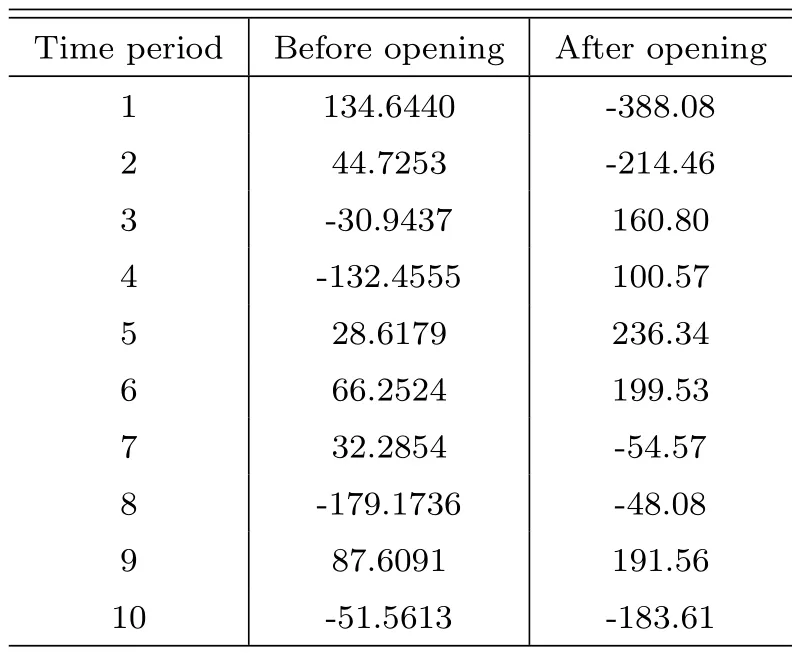
Table 6 Comparison before and after opening
Based on the principles that the higher the comprehensive evaluation value is,the better the traffic situation can be estimated,the following analysis result can be obtained from the data in the above table:
(1)Regardless of whether the community is opened or not,the traffic situation has a strong time-domain characteristic.
(2)The opening does not unilaterally enhance or impede the quality of the surrounding roads,but will have di ff erent impacts under di ff erent traffic conditions at di ff erent time periods.
(3)Since the data after opening is the case analysis based on assumptions,and the value of final evaluation indicators are discrete,these values lack of certain rationality,but for the comprehensive indicator value of the evaluation of the original data falls into the confidence level,it can still be deemed as reasonable.
§5. Conclusion
To evaluate the impact of opening residential communities on traffic congestion,this paper adopted the principle of dynamic comprehensive evaluation.Combined with the principle of”Variation Driven”,we calculated the comprehensive indicators in the form of numerical value,which showed the quality of road traffic situation vividly and visually.Combined with the simulation,we concluded that the impact of opening residential communities on traffic is varied for di ff erent period of time.Therefore,the community should be opened according to di ff erent periods of time so as to achieve road diversion in the peak and not to disturb the traffic on the main surrounding roads in a wide range during non-peak periods.The dynamic comprehensive evaluation model adopted in this paper is intuitional and easy to understand.However,the selected evaluation function was a linear function because the lack of data.We will find a more accurate evaluation function with full support of the original data.
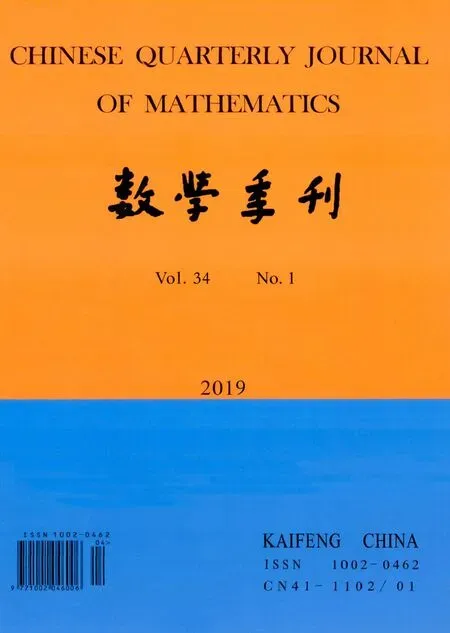 Chinese Quarterly Journal of Mathematics2019年1期
Chinese Quarterly Journal of Mathematics2019年1期
- Chinese Quarterly Journal of Mathematics的其它文章
- A Remark on Double Ore Extensions
- Lyapunov-type Inequalities For A System of Nonlinear Di ff erence Equations
- Analysis On an SEIRS Epidemic Model with Pulse Vaccination and Two Time Delays
- The Cohomology Structures of Partial Entwining Structures
- Some Results on H-cordial Graphs and Semi-H-cordial Graphs
- An Improvement in Ordered Cone b-metric Spaces Over Banach Algebras
